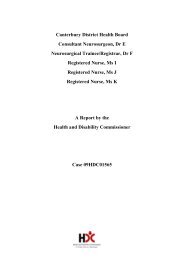Gisborne Hospital Report - Health and Disability Commissioner
Gisborne Hospital Report - Health and Disability Commissioner
Gisborne Hospital Report - Health and Disability Commissioner
Create successful ePaper yourself
Turn your PDF publications into a flip-book with our unique Google optimized e-Paper software.
<strong>Gisborne</strong> <strong>Hospital</strong> 1999 – 2000<br />
Operating Theatre Protocols<br />
9.16 The choice of the most appropriate anaesthetic approach will be influenced by<br />
the history of the child <strong>and</strong> family <strong>and</strong> the results of examination. There is no<br />
“one way” to induce anaesthesia in children.<br />
9.17 A common paediatric induction method is the “mask” induction. During this<br />
type of induction, a mask is gently applied to the childs’ face <strong>and</strong> increasing<br />
concentrations of an inhalation agent (usually halothane, or more recently<br />
sevoflurane) are added to oxygen with or without nitrous oxide. The<br />
advantage of mask induction is that it can be relatively rapidly instituted <strong>and</strong><br />
does not require insertion of intravenous (IV) catheters in awake patients. IVs<br />
can easily be inserted after children are anaesthetised. However, some patients<br />
need their airways to be very rapidly safeguarded against the risk of vomited<br />
or regurgitated stomach contents <strong>and</strong> mask induction may not be appropriate.<br />
9.18 Such patients, along with others with specific medical conditions, or those<br />
who present to the operating room with an IV in place, are induced with IV<br />
agents. These agents include thiopentone, propofol, ketamine, etomidate, <strong>and</strong><br />
occasionally high dose narcotics or benzodiazepines. Even when an IV is not<br />
inserted before induction, it usually is once the patient is anaesthetised in order<br />
to provide a route to give any medicines that might be required for the<br />
continuance of anaesthesia or other purposes.<br />
9.19 Whether an IV line is used to give an anaesthetised child intravenous fluids<br />
depends on a number of circumstances, eg, how long the patient has been<br />
fasting <strong>and</strong> how long it is before the patient is expected to be able to take<br />
fluids.<br />
9.20 My expert anaesthetist also advised that “comments from <strong>Gisborne</strong> suggest<br />
that there was a lack of familiarity with the nuances of paediatric anaesthesia”,<br />
<strong>and</strong> that Dr Lucas failed to communicate his plans <strong>and</strong> their rationale to staff.<br />
Dr Lucas responded that it was “not for want of trying”, <strong>and</strong> that he had been<br />
trying to teach that particular technician about such matters for months.<br />
Opinion<br />
9.21 In my opinion, none of Dr Lucas’ acts or omissions in administering<br />
anaesthesia to child patients amounted to a failure to exercise reasonable care<br />
<strong>and</strong> skill. Nor is there any evidence that Dr Lucas failed to communicate<br />
effectively with child patients <strong>and</strong> their parents or guardians, whatever may<br />
have been his failings to communicate to colleagues. Accordingly, Dr Lucas<br />
did not breach Right 4(1) or Right 5(1) of the Code.<br />
113
















